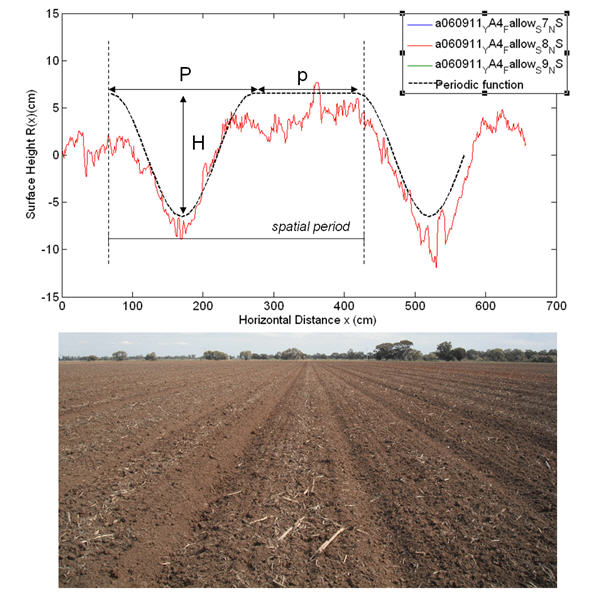Surface Roughness Sampling
Soil surface roughness affects both the radiometric and radar observations. Radar observations can, in certain conditions, be more sensitive to surface roughness than soil moisture itself due to the increased scattering of the incoming radiation. Moreover, surface roughness affects the radiometric observations by effectively increasing the surface area of electromagnetic wave emission. Its effect on observations at L-band frequency has been difficult to quantify, and therefore it is crucial to characterise the spatial variation of this parameter across the different land cover types.
During SMAPEx-5 surface roughness was characterized at 3 locations within each major land cover type in the six focus radar pixel areas. At each of the locations two, 3m-long surface profiles were recorded, one oriented parallel to the look direction of the PLIS radar (East-West) and one perpendicular (North-South). Over furrowed area, additional sampling along and cross row direction were taken. Surface roughness was also measured at selected forest sites once during the campaign. Two perpendicular measurements per site were taken. The location was to be selected by Team leader and could be inside of one of the subplots or in the buffer areas, but must be located under the forest canopy following the established protocols. For sites with sparse forest cover the roughness was taken for the most representative vegetation type (e.g. grass, shrubs, etc.). For each roughness profile photos of the surrounding vegetation were and their ID noted in the field form. Complete details on the surface roughness sampling strategy and protocols can be found in the SMAPEx-5 workplan.
The roughness pin profiler and sampling activity
Surface roughness sampling schedule
Focus area
Surface type
Date sampled
Nr.
measurementsYA4 Wheat 10/09 3 YA4 Bare soil 10/09 6 YA4 Native 10/09 1 YA4 Burnt stalk 18/09 2 YA4 Wheat 18/09 1 YA4 Pasture 18/09 3 YA4 Lucern 21/09 1 YA4 Grass 21/09 1 YA4 Grass 23/09 1 YA4 Bare soil 23/09 3 YA4 Wheat 23/09 3 YA7 Wheat 12/09 3 YA7 Bare soil 12/09 3 YA7 Canola 12/09 1 YA7 Lupin 12/09 1 YA7 Wheat 23/09 1 YF Native grass 15/09 3 YF Rice stubble 15/09 2 YF Pasture 15/09 1 YF Wheat 15/09 1 YF Wheat 25/09 6 YF Grass 25/09 3 YF Rice 25/09 2 YE Pasture 18/09 3 YE Wheat 26/09 4 YE Grass 26/09 1 YE Wheat stubble 26/09 1 YB Pasture 16/09 7 Forest Forest 16/09 3 Forest Forest 26/09 7
Surface roughness processing
Surface roughness statistics were calculated using the QuiP MATLAB software package. Users can download all data via the Download Centre. Data were processed as follows:
1. Surface roughness statistics were calculated on the raw profile and are provided in the "one scale" columns (NOTE: correlation length is calculated from the experimental Autocorrelation function)
2. In the cases where multi-scale roughness was observed, spectral analysis was performed to separate the high (microscopic) from the low frequency roughness. All statistics are provided in the "two scale" columns, together with the frequency K (in radians/meter) used to separate the high from the low frequency component of the roughness spectrum by Fourier transform.
3. In the case where a periodic structure was observed, a mathematical function was fitted to model the variation in local incidence angle due to the periodic structure. The average, minimum and maximum of the values of the function parameters for each paddock were derived from the experimental profiles.

Example of function to model periodic structure